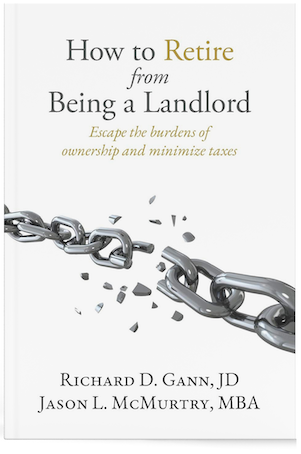
How to Become a Passive Landlord
Enjoy the potential benefits of real estate without the headaches? “Impossible!” you say. Yet billions of dollars are invested in passive replacement real estate every year. Many of your fellow housing providers have figured this out, and are making the change from active to passive ownership.
To be clear, we are not talking about exchange-traded securities. To be a bona fide real estate investment, its return must reflect the performance of the underlying properties.
A common example of bona fide passive real estate—to replace your current property—is a Delaware Statutory Trust (“DST”). All DSTs share a common trait: third parties are responsible for operating the premises.
Put more simply, investors in 1031-qualified DST programs are merely along for the ride:
- No purchase negotiations
- No loan application
- No leasing, deposits or evictions
- No management, maintenance or make-ready hassles
- No bill paying or accounting
- No sales negotiations
The suitability of any investment option depends on your preferences. Do you want to apply for your own loan and be personally liable for the payments? If so, a DST may not be a good option. Do you want to invest in smaller properties that are limited to just a few investors? Again, a DST may not be the way to go. But if you prefer an opportunity to invest in a large portfolio of properties, perhaps the DST structure may be more your speed.
Syndicated passive replacement programs allow active landlords to exchange their rentals for properties operated by other people. Such properties may be located in other states that offer more appealing prospects for demographics, economics, regulations and taxation. One can achieve portfolio diversification with DSTs to a degree not possible with self-owned real estate.
Of course, when it comes to releasing control, what attracts some investors may repel others. Passive replacement programs may be highly illiquid. And DSTs include substantially greater fees than traditional real estate.
To make the transition from active to passive ownership, you must take the first step with a qualified real estate broker to list your rental. Once your property is under contract, retain an exchange accommodator to receive the proceeds of your sale from escrow. Finally, consult with a real estate investment firm like 1031 Capital Solutions to help you find and invest in a 1031-qualified replacement program.
Like many housing providers, you may wish to remain invested in multifamily real estate. Most passive replacements we have access to are large, class-A apartment communities located in suburbs of major markets in the Midwest and Southeast. Complementary asset types include self-storage and senior housing, for example.
2021 was a record year for real estate appreciation, following a dozen years of consistent value growth. 2022 may prove to be at or near the top of the cycle. In an upcoming 1031 exchange, you are likely to sell high but also buy high. It is important to have realistic expectations for the next several years of real estate performance, and to recognize that the near future may not mirror the recent past.
Although capitalization rates are not tied precisely to interest rates, the Fed’s tightening policies almost certainly will drive cap rates up in the coming months. Whether this will impact cap rates in 5-10 years we can only guess, but the prospect of higher “exit cap rates” puts a premium on potential revenue growth. Passive investments in sectors with short-term leases (e.g., multifamily, self-storage, senior housing, student housing, for example) may have a better opportunity to increase net operating income over time. In turn, such properties may have a fighting chance to preserve value when cap rates rise.
Regardless of whether you invest in apartments, self-storage or industrial buildings, passive replacement properties offer the opportunity to live a different lifestyle as a real estate owner. To learn more, please visit 1031capitalsolutions.com or call (800) 445-5908.
____________________
This is for informational purposes only, does not constitute as individual investment advice, and should not be relied upon as tax or legal advice. Please consult the appropriate professional regarding your individual circumstance.
DST 1031 properties are only available to accredited investors (typically defined as having a $1 million net worth excluding primary residence or $200,000 income individually/$300,000 jointly of the last three years; or have an active Series 7, Series 82, or Series 65. Individuals holding a Series 66 do not fall under this definition) and accredited entities only. If you are unsure if you are an accredited investor and/or an accredited entity, please verify with your CPA and Attorney.
There are material risks associated with investing in DST properties and real estate securities including liquidity, tenant vacancies, general market conditions and competition, lack of operating history, interest rate risks, the risk of new supply coming to market and softening rental rates, general risks of owning/operating commercial and multifamily properties, short term leases associated with multi-family properties, financing risks, potential adverse tax consequences, general economic risks, development risks, long hold periods, and potential loss of the entire investment principal.
Potential cash flows/returns/appreciation are not guaranteed and could be lower than anticipated. Diversification does not guarantee a profit or protect against a loss in a declining market. It is a method used to help manage investment risk.
Statements concerning financial market trends are based on current market conditions, which will fluctuate. Past performance is not indicative of future results.
Securities offered through Concorde Investment Services, LLC (CIS), member FINRA/SIPC. Advisory services offered through Concorde Asset Management, LLC (CAM), an SEC registered investment adviser. 1031 Capital Solutions is independent of CIS and CAM.
continue reading
Related Posts
When the Federal Reserve (the Fed) adjusts its target interest […]
1031 Industry Veterans Launch Proprietary Software for Rental Housing Providers […]
When it comes to building and preserving generational wealth through […]











